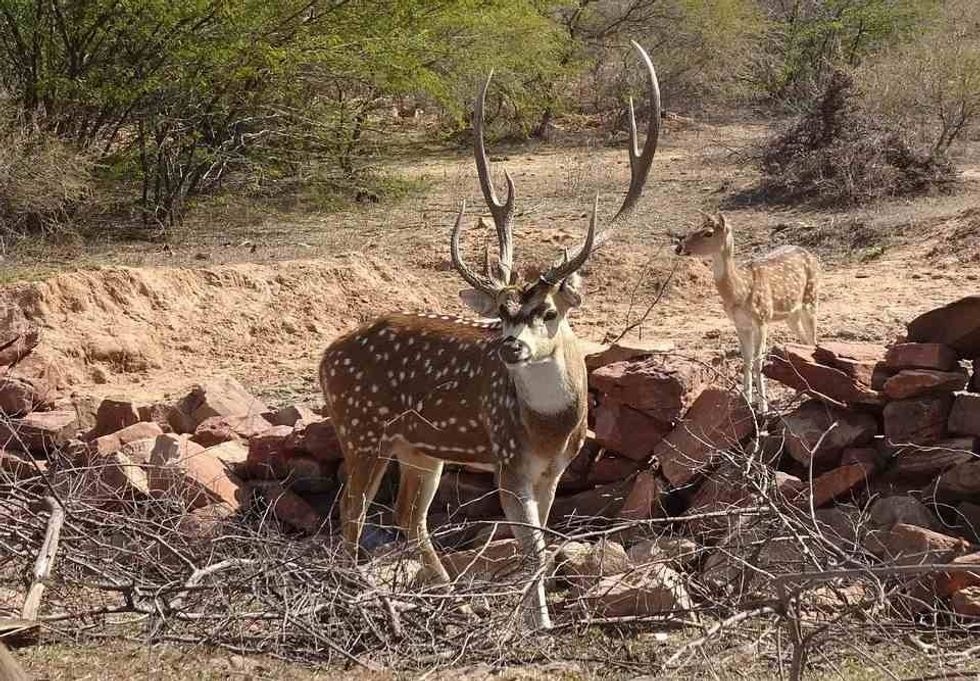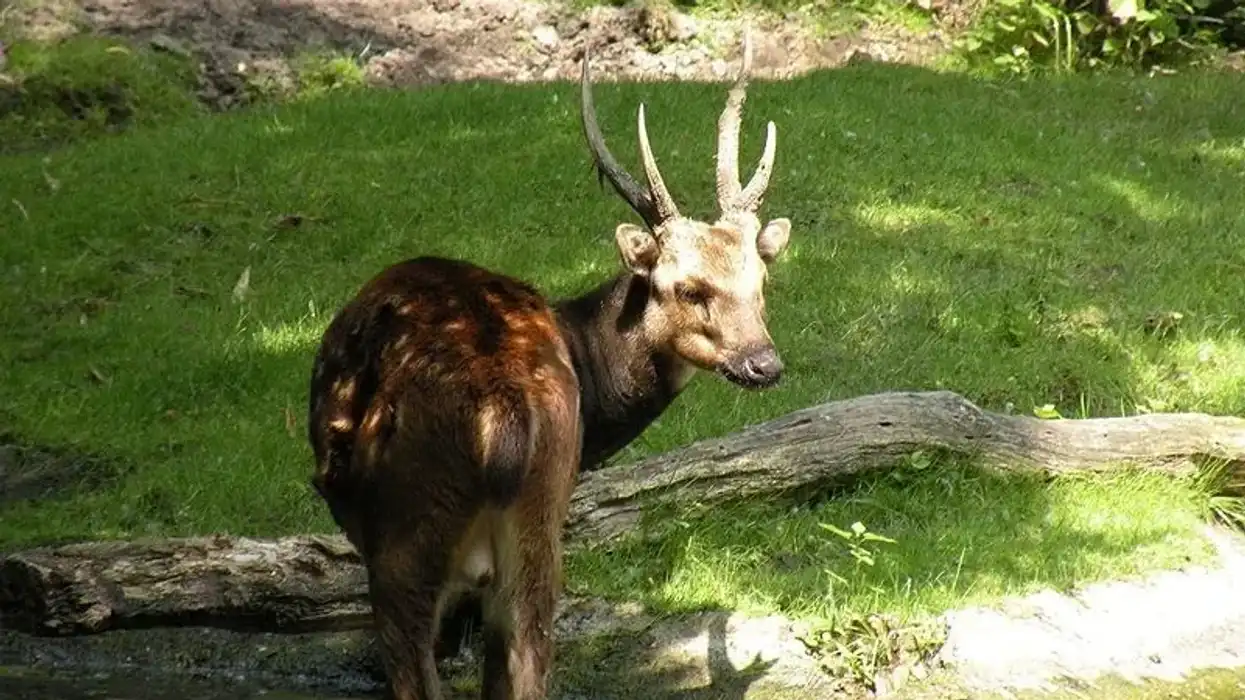Originating in the Indian subcontinent, the Axis deer is one of the most beautiful species of deer and can easily be found in various countries such as Australia, the United States, and Croatia. The deer is known by different names such as the spotted deer and chital deer.
The former name is native to countries such as India, Bangladesh, and Sri Lanka. The term chital has been derived from 'Chitrala', a Sanskrit word that means spotted.
The golden color along with white spots makes the upper body more fascinating, while the remaining body is all white. An average male weighs around 66-165 lb whereas an average female weighs around 55-99 lb.
Their antlers are around 39 in long. Grassland is the major habitat of these animals as they usually eat grasses, and they are also found in many national parks and forests.
In the first decade of the 19th century, the first chital deer were brought to Australia from Sri Lanka, while after the mid-19th century, the species were introduced in Hawaii of the United States of America as a present from Hong Kong. With the coming of the 20th century, many herds were also spotted in Texas.
The native population of Texas also loved the animal and after then the population of the animal has been rising rapidly. Keep on reading to learn more interesting things about Axis deer.
If you want to know more exciting facts about other animals, check out the Percheron and reindeer.
Axis Deer Interesting Facts
What type of animal is an Axis Deer?
The Axis deer is one of the intelligent species of deer and is an herbivore. Most of them are usually found in Asian countries such as India, and Sri Lanka.
What class of animal does an Axis Deer belong to?
An Axis Deer belongs to the mammal class of animals.
How many Axis Deers are there in the world?
There is no exact population of Axis deer but the International Union for Conservation of Nations has categorized the species as Least Concern.
Also, countries like India and Bangladesh have made various laws and provisions to protect the spotter deer such as the Wildlife Protection Act of 1972, and the Wildlife Preservation Act of 1974 as the population was declining because of habitat loss.
Axis deer are spread throughout the world and as of now, the species can be found in countries like Mexico, Argentina, and Brazil as well, thus the population of the deer is increasing rapidly.
Where does an Axis Deer live?
The Axis deer are found in various countries such as India, Sri Lanka, Bangladesh, Australia, the United States, and many more. In India, the species are found in many states, since the early decades of the 19th century, spotted deer can easily be seen in Queensland and New South Wales.
In the United States, the axis deer first appeared on the Hawaiian islands and since then these beautiful spotted deer have become an important part of the wildlife.
What is an Axis Deer's habitat?
Primarily, the Axis deer habitat is generally grasslands and forests as their main food is grasses. In India, the species can be seen in forested valleys, plains, and many national parks.
In other countries as well the habitat of the axis deer remains the same. The herd of the axis deer has also been spotted at the foothills of mountains.
Who does Axis Deer live with?
Like any other species of deer, the Axis deer lives in herds. The size of a herd varies from country to country, the size of a herd in India is generally large.
Primarily the females or doe and their fawns live together while the males, also known as buck herd together. The size of the herds ranges from three to five.
How long does an Axis Deer live?
The average lifespan of an Axis deer is 9-13 years but a few of the deer may live up to 18-20 years.
How do they reproduce?
The mating pattern followed by the axis deer is monogamy which means the male or buck tries to stick to a single female axis deer. The breeding season differs in every country but generally, every buck uses its antlers or horn to grab the attention of the axis deer doe.
Like any other species of deer, the female chital goes through an oestrus cycle in which the deer expresses signs of mating behavior. The male axis deer became less active during the development of the antlers.
The pregnancy or gestation period lasts for around seven to eight months.
After the birth, females usually hide the axis deer babies for a few days. Also, the bond between the baby or fawn with its mother is not very strong compared to other mammals.
What is their conservation status?
As the population of the axis deer is least affected, the International Union for Conservation of Nature has listed the species in the Least Concern category. As of now, there are very minimal possibilities of danger to the species.
But a few decades ago, to prevent habitat loss and human intervention, different countries introduced certain laws and provisions to protect the species.
In 1972, the Indian government passed the Wildlife Protection Act and the Bangladesh government introduced the Wildlife Preservation Act in 1974. Several other countries are very vigilant to protect the beautiful species of spotted deer.
Axis Deer Fun Facts
What does Axis Deer look like?
Axis deer are so attractive and you can often see the mother Axis deer sitting with her fawn under the shade. Doe or female Axis deer do not have antlers as they are only present on males or bucks.
The females are generally smaller in size and you can spot the golden color with white spots on the upper body of the female deer in the image.
How cute are they?
One of the most beautiful creatures on this planet would be the fawn or young axis deer. The golden color along with white spots make them more attractive. When we talk about adult axis deer, their short tales and antlers are also a delight to see.
How do they communicate?
Like other animals or deer species, the Axis deer follow the same communication method and try to communicate through their body language and different signs and sounds. The prominent means of communication is vocalization, they are very vocal during the mating seasons.
The fawns of axis deer call or usually squeal after getting separated from the females. Also, the male axis deer sounds quite unusual and they often moan when they get violent and combative.
How big is an Axis Deer?
The Axis deer is one of the largest deer and when we talk about height and weight, the Axis deer is twice the height of the Pudus deer and the Axis deer is five times heavier than the Pudus. Also, the Axis deer has one of the longest antlers among all the animals.
How fast can an Axis Deer move?
Mostly, the Axis deer dwell in forests and have to save them from wild animals. The average speed of an axis deer is between 37-40 mph (60-65 kph). The deer is also best known for its fast reflexes and most of the time saves its life when some wild predators attack.
How much does an Axis Deer weigh?
The weight of males and females varies, the average weight of a buck axis deer is 66–165 lb (30-75 kg) whereas a female axis deer weighs around 55–99 lb (25-45 kg).
What are the male and female names of the species?
The male axis deer is known as a buck whereas the female deer is called a doe.
What would you call a baby Axis Deer?
We would call a baby Axis deer a fawn.
What do they eat?
As the Axis deer are herbivores, the Axis deer diet is generally plants, vegetation, and grasses. Sometimes, the axis deer is also fed by humans.
Are they dangerous?
These animals are indeed very cute and beautiful but they can be very dangerous when they are alone or in herds. They can attack any other domestic animals, and humans, and can destroy plants and vegetation as well. Also, their antlers are very sharp which can cause death to anyone.
Would they make a good pet?
The answer to this question can be either yes or no. You can think of fawns as a pet as they are small and easily be managed and tamed.
Though adult is not quite safe to pet as they become more cautious and dangerous. Therefore they belong in the forests and are not recommended to be your pets as safety matters the most.
Did you know...
The male axis deer have a black spot on their face and a white spot on their throat that helps people to identify the gender of the animal.
The Axis deer is quite good in taste as the meat is very soft and tender and in older times the meat was considered as the best meat as well.
All Axis deer have spots.
Usually, Axis deer do not invade but there are a few instances from Texas where Axis deer have occupied the habitat of other herbivore animals. Also, when the size of the herd becomes large they often attack natives and destroy the local vegetation.
Most Axis deer drop their antlers in the winter season.
Are Axis Deer bigger than Whitetail?
Originating in North America, the Whitetail is also known as the Virginia deer and is one of the largest and most muscular species of deer. An average Whitetail weighs around 220-308 lb (100-140 kg) whereas some also reach around 374-396 lb (170-180 kg).
While talking about the height, can reach up to 43-47 in (110-120 cm). Thus, Axis deer are smaller than Whitetail deer.
How did Axis Deer get to Texas?
Before Texas, the Axis deer were introduced in Hawaii. After the mid-19th century, a king from Hong Kong gifted the Axis deer to the United States, and was first brought to Hawaii.
After that, the animal became popular among the native population. Whereas, around the third decade of the 20th century, Axis deer in Texas were introduced. The animal came to Texas as a game animal but later became a wild animal and the herds started appearing in different parts of Texas.
The other purpose of bringing the animals to Texas was that the native population wanted the deer as a hunting option. Axis deer in Texas were mostly found on the Edwards Plateau.
Here at Kidadl, we have carefully created lots of interesting family-friendly animal facts for everyone to discover! Learn more about some other mammals including Pudus or fallow deer.
You can even occupy yourself at home by drawing one on our Axis Deer coloring pages.









